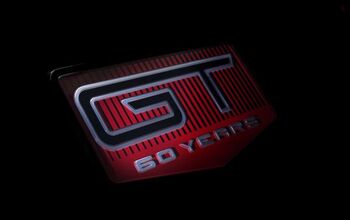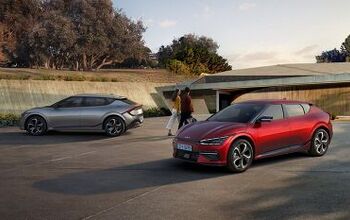Before E-Power Makes It Here, Nissan First Has to Send It to the Gym

Whether the buying public likes it or not, there’s a tsunami of electrified powertrains headed for U.S. shores. Automakers the world over hope to beat their rivals in the race to a “fully electrified” lineup, which just means there’ll be — at a minimum — a hybrid variant in each model line.
It’s far less sexy than headlines make it sound. Still, if you’re into technology and saving money at the pumps (not necessarily at the dealer), it’s hot stuff. Nissan’s taking an unconventional route in this race, forgoing a conventional hybrid setup for an inexpensive stopgap solution all its own.
The system, called e-Power, is already a hit in Japan. But before it makes its way into high-end Nissan products (read: Infiniti), it first needs to upsize the system for American-sized vehicles travelling at American-sized speeds. That’s not as easy as it sounds.
e-Power combine an electric motor and a conventional gasoline engine, but, unlike a normal hybrid, the two powerplants do not take turns handling propulsion duties. The continuously running ICE (operating at a fixed rpm) continuously feeds a small battery via a generator, which in turns powers the electric motor that drives the wheels. Propulsion always comes from the electric motor, but the battery’s juice always comes from an ICE. (A small amount of energy is recaptured via regenerative braking.)
Launched in Japan in late 2016, the little Nissan Note e-Power hatchback utilizes a 1.2-liter four-cylinder running at a constant 2,500 rpm for its electricity generation. The automaker claims 70 percent of Note buyers in that market choose e-Power, making the vehicle line quite a profitable one. Nissan has since added e-Power to a midsize minivan.
Unfortunately, flitting around the crowded urban streets of Japan is a very different situation than intercity travel in Europe or the United States. For the vehicle to be ultra efficient, the engine needs to operate at an optimum speed. However, sustained high-speed cruising would deplete the battery faster than the engine/generator could replenish it.
This is what Nissan’s trying to figure out as it contemplates launching e-Power in Europe — and whatever lessons learned on the continent will surely be applied to the U.S., where Nissan promises e-Power availability in the near future. Its Infiniti division plans to go “electrified” by 2021, and it’s much easier to hide additional powertrain costs in a pricier vehicle’s sticker.
Ponz Pandikuthira, Nissan’s vice-president of product planning, told Automotive News Europe that “Japanese driving rewards e-Power,” but the equation falls apart outside the city. Still, the system’s efficiency still tops that of diesel propulsion by 10 to 15 percent, he said. Because of the system’s benefits, it seems Nissan plans to do whatever’s necessary to adapt it to Western roads.
“EPower is far less expensive to execute than a plug-in hybrid because you don’t have the extra costs and 400 kg of the battery weight,” Pandikuthira said, calling e-Power “a great bridge technology.”
Testing is ongoing at Nissan’s UK R&D facility with a Nissan Altima outfitted with a 2.4-liter engine/generator, he added.

More by Steph Willems
Latest Car Reviews
Read moreLatest Product Reviews
Read moreRecent Comments
- SCE to AUX This was the same car I had (05 xB, stick, "camouflage" color) for 7 years - great car.We called ours "The Lunchbox". I added aftermarket wheels, and the 3rd-party cruise control the dealers could install.It suffered only two failures: bad window switch in week 2 (dealer fixed in 1 hour), bad trailing O2 sensor (fixed myself for $70). Fuel economy was always 28-34 mpg.It was a potential death trap, and ride quality became unbearable after 2 hours. I once did a 10-hour round trip in it and could barely walk after.Traded it for a 2012 Leaf, which was a better car in some ways.
- Bd2 The "e" nomenclature signifies the e-ATPs which BMW is pursuing.
- Dave M. I'm sorry to see any storied name go away. The lifespan of the Malibu has fit perfectly in my lifetime years-wise. Some of the highlights include the first and second generations, the '78 revamp (very clean design), and the 2005 generation. Ford, GM and Mopar gave this segment away by allowing Toyota and Honda a foot in the door and then always having to play catch-up. How hard is it to make a truly competitive sedan at a profit? Obviously, Japan Inc. figured it out.I've driven a few rentals these past years; the Malibu got the job done but honestly the Passat and Altima were my rental preferences.
- Kcflyer actually yes. It's a shame that a product this uncompetitive can still outsell GM's entire EV offerings. Those products have had billions thrown at them. Imagine how nice the new Malibu, Impala, SS, and Lacrosse would be with that kind of commitment.
- 3SpeedAutomatic Nope....



































Comments
Join the conversation
AHA ! Thank you, Best & Brightest !
This is what a BMW i3 turns into when the biggish battery runs down and the Mighty Powerhouse 700cc two cylinder "range extender" allows you to mope along to a charging station. There's zero to see here technically. Nothing at all. It's a Mark 1 series hybrid system chosen by no one else for an obvious reason. It only works properly in city traffic. On the highway, a gas engine encumbered by driving a generator as well as a battery driving an electric motor both involve energy conversion losses that a straight gear drive avoids. In town you can juggle things about for a gain. GM's mild hybrid from 2008 on, and the new German 48V hybrid system, also picked up by Chrysler for the new V6 RAM, are somewhere between Mark 0 and Mark 1. All pimples on the path of progress, but no doubt soon to be deified by overenthusiastic PR donkeys trained to bray appropriately as if the world had been transmogrified for the better in a startling way. What they really do is provide a darn good fast start in a stop/start system, or drive an engine for a few seconds to cover up low rpm main turbo lag, still not really covered up by all these new designs.